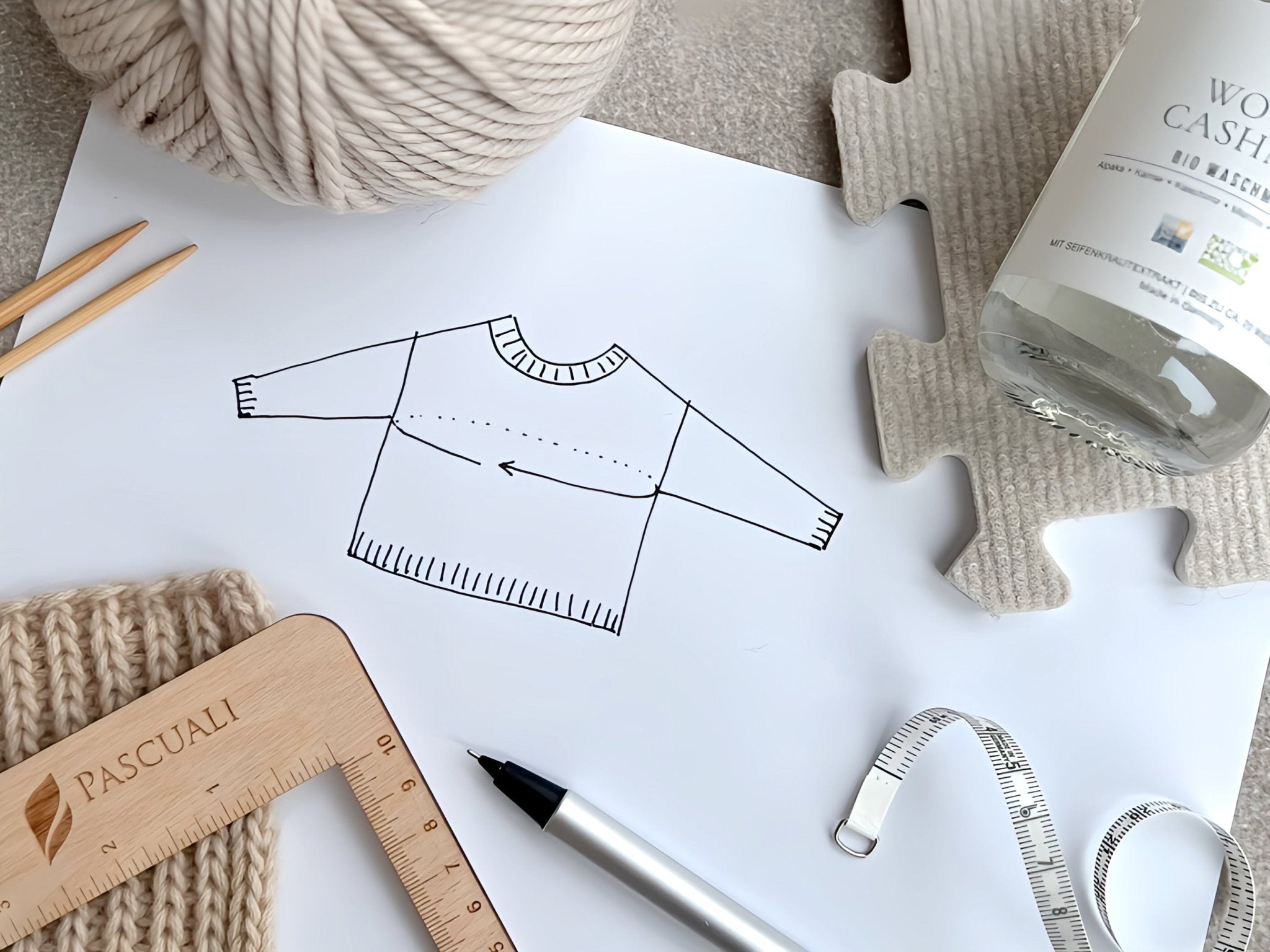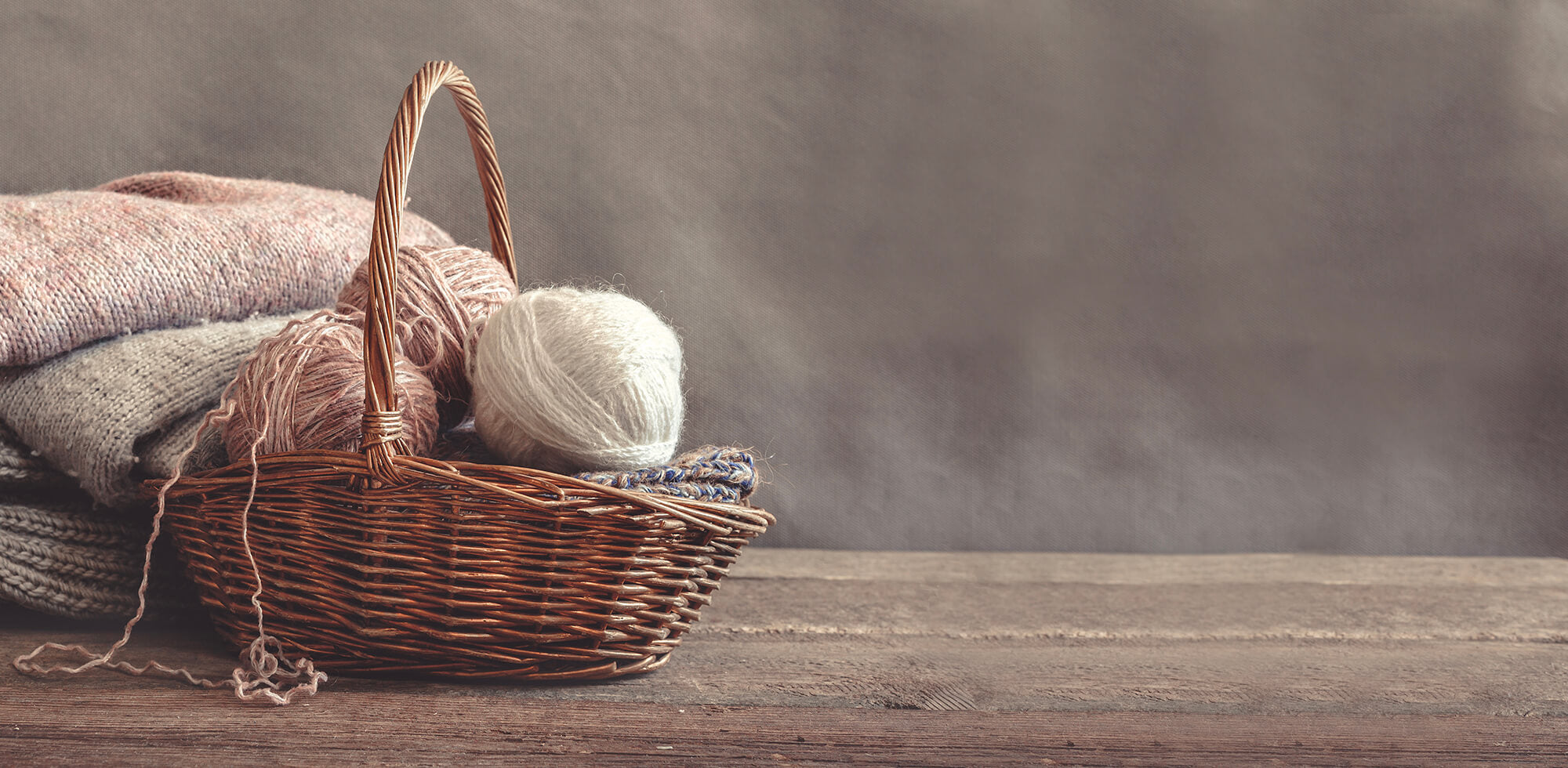By Claudia Ostrop
A little while ago, we published the first part on the subject of Brioche Knitting also known as English Rib Pattern.
We introduced you to basic brioche, Fisherman´s Rib and Mock or Fake brioche and the various techniques for knitting this voluminous rib pattern in rows and rounds.
So, are you ready for more? We are going to add some colours and we´ll take a closer look at how this pattern is worked.
Two-Colour Brioche
The English Rib patterns can also be knitted in two colours: This results in a kind of vertical striped pattern with the knit and purl ribs appearing in alternating colours.
Depending on the colour combination you choose - more tone-in-tone or with strong contrasts - great effects can be created. Be careful though, this lavish ribbing, swallows up a lot of yarn!
The Mock Brioche can, of course, also be knitted in two colours, but since these are regular knit and purl stitches, the effect achieved is not the same as with the real brioche.
Two-Colour Brioche
Although the rib pattern is identical on the front and the back sides, the two-colour scheme is not: The dominant colour is on the knit rib. So that each side will vary slightly, with one colour being more dominant on one side than the other. Depending on your mood (and if all the yarn ends are neatly weaved in.) knitted items can also be worn inside out. Based on the colour combination, great effects can be achieved with a two-colour brioche.

Basic Two-Coloured Brioche with Yarn Overs in Rows
It is important that you use a circular knitting needle or two double pointed needles, depending on the size of the project because each of the two rows in two-colour brioche is worked twice, once in each colour: twice the front row, then twice the back row. Because you will be sliding stitches back to the right needle after working the first row, both ends of the needle must be accessible. Therefore, you need DPNs or circulars, not a needle with a stopper.
First, decide what colour should be the dominant one. This is the main colour (colour A), the other is the secondary colour (colour B). Loosely cast on an even number of stitches using colour A, slide the stitches to the end of the needle and join in colour B.
All "A" rows are worked with Color A and all "B" rows are worked with Color B.
Set-up row with colour B: *sl1yo, p1; rep from * to end. Turn work.
Row 1A: *sl1yo, brp1; rep from * to end. Slide the stitches to the end of the needle.
Row 1B: *brk1, sl1yo; rep from * to end. Turn work.
Row 2A: *brk1, sl1yo; rep from * to end. Slide the stitches to the end of the needle.
Row 2B: *sl1yo, brp1; rep from * to end. Turn work.
Repeat these four rows until the fabric is as long as you like, ending with Row 2B.

Basic Two-Coloured Brioche with Yarn Overs in Rounds
Knitting in the round is practically the same, except that you don't have to turn your work because you automatically get to the next colour at the end of the round. The rounds are knitted alternately in the main and secondary colours.
Cast on the desired number of stitches with the main colour (colour A). Without turning on the work, slide the stitches to the other tip of the needle and attach colour B. You are facing the right side of the work.
Setup round with colour B: wyif, *sl1yo, p1; rep from *.
Place marker and join for working in the round, being careful not to twist the stitches.
Round 1A: *brk1, sl1yo; rep from *.
Round 2B: wyif, *sl1yo, brp1; rep from *.
Repeat these two rounds till you get the desired length.
Two-Colour Fishermn´s Rib in Rows
If you prefer knitting the stitch below rather than working with yarn overs, you can of course also do it in two colours.
Cast on stitches in colour A.
Knit one row in colour A, then attach colour B. These are your setup rows. You’ll now start to work the four-row repeat as follows:
Row 1B: k1, k1b; Slide stitches back to other end of needle, as the next row will be worked in the same direction.
Row 2A: p1b, p1; Turn work.
Row 3B: p1b, p1; Slide stitches back to the end of the needle and work next row in the same direction.
Row 4A: k1, k1b; Turn work.
Two-Colour Fishermn´s Rib in Rounds
Cast on the desired number of stitches in the main colour.
Cast on an even number of sts in the main colour (colour A) and join in the round. Continue working with the second colour (colour B).
Set up row in colour A: k1, p1
Row 1A: k1b, p1
Row 2B: p1b, k1
Repeat these two rounds till you reach the desired length.
Two-Colour Half-Brioche
Of course, the half-brioche can also be knitted in two colours. However, the front and back differ significantly here. The back looks completely different and has nothing to do with the clear rib pattern on the front.

Two-colour Half Brioche with Yarn Overs in Rows
Cast on an even number of stitches with the main colour (colour A).
Row 1A: sl1yo, k; Slide stitches to the end of the needle.
Row 1B: p2tog, k1; Turn work.
Row 2A: p1, sl1yo; Slide stitches to the end of the needle.
Row 2B: k2tog, p1; Turn work.
Repeat these four rows till you get the desired length.
Two-colour Half Brioche with Yarn Overs in Rounds
Cast on an even number of stitches in the main colour (colour A) and continue with the secondary colour (colour B).
Round 1B: sl1yo, p1
Round 2A: k2tog, p1
Repeat these two rows till you get the desired length.
Two Colour Half Fisherman´s Rib in Rows
Cast on an odd number of sts with colour A.
Set-up row (with colour A): k all sts. Turn work.
Row 1b: k1, *p1b, k1. Repeat from *to the end. Slide stitches to the end of the needle.
Row 2a: k1, *p1, k1b. Repeat from *to last 2 sts, p1, k1. Turn work.
Row 3b: k1, *k1b, p1. Repeat from *to last 2 sts, p1b, k1. Slide stitches to the end of the needle.
Row 4a: k1, *k1, p1b. Repeat from *to last 2 sts, then k2. Turn work.
Repeat these 4 rows for the pattern.
Two Colour Half Fisherman´s Rib in Rounds
Cast on an even number of stitches in the main colour (colour A) and join in the round.
Set up row with colour A: k1, p1
Row 1A: k1b, p1
Row 2B: p1b, k1
Repeat rows 1 and 2 to desired length
Now you are able to knit wonderfully chunky ribs. However, only in a straight line and in one width. This is perfectly enough to be able to knit beautiful scarves, but you can knit lots of other things as well! That´s the topic of our next chapter!
One and Two- Colour English Rib Patterns - Increases and decreases
So that the rib structure is retained, double increases or decreases must always be worked when knitting English Rib patterns, i.e. you always increase or decrease two stitches at a time.
Increases and decreases are not only suitable for changing the number of stitches: if you combine increases with inclined decreases, you can "paint" beautiful patterns with the twisting ribs.
English Rib Decreases
Depending on where they take place, they are knitted with a degree of inclination: As with "normal" decreases, i.e. leaning to the right or left.
Left Leaning Decreases
Slip the next stitch (with its yarnover) knit wise to the working needle, brk the following 2 stitches together (i.e. knit both together with the yarnover on the second stitch). Pass the slipped stitch over the stitch just worked. On the next round/row, the resulting single stitch is worked as a sl1yo and incorporated into the brioche rib as normal on subsequent rows/rounds.
Right Leaning Decreases
Slip the next stitch knit wise, with its yarnover, to the working needle. Knit one stitch.
Pass the slipped stitch over the stitch just worked. Slip stitch just worked back to passive needle. Slip second stitch on passive needle over the first stitch. Slip stitch from passive needle to working needle. On the next round/row the resulting single stitch is worked as a sl1yo and incorporated into the brioche rib as usual on subsequent rows/rounds.
English Rib Increases
To increase, two additional stitches are knitted out of an existing stitch. Where there was one before, there are now three stitches:
Insert the needle into the stitch and pull the yarn through as if to knit - but leave it on the needle. Make a yarn over, knit one more stitch and then slip it off the needle.
Be aware that for stitches that are worked one below, the increase is also made one stitch below!
In the following row or round, the new stitches are integrated into the existing pattern, i.e. knitted or purled, with yarn over or worked below.
Don't drop that Stitch...
Concerns about dropped stitches or other mistakes when knitting English rib are not unjustified. We don't want to fool anyone here - it takes a certain amount of routine and experience to repair a stitch that has fallen off the needle. With the two-colour brioche it is even easier because the colours guide you a bit more. Let´s ignore complicated rescue operations and take a different approach: the lifeline.
The Lifeline

A lifeline is a preventive measure that keeps stitches safe in case you need to unravel them later on. If you discover a mistake or if you have dropped off one or more stitches, you can simply unravel down to this safety line and simply guide the needle through the stitches. Depending on how often you "update" the lifeline, you will not waste too much time repairing the damage. It is definitely easier than desperately struggling with yarn overs and undefinable rows, isn't it?
Hanging from a Thread of Yarn

You can pull in the lifeline by threading a piece of yarn (preferably in a contrasting colour) through a wool needle and running it through all the stitches that are sitting on the knitting needle. Make sure to tie a bow at each end of the lifeline!
So, now that you know all about Brioche and English Rib patterns, you are ready to try them out. Need some inspiration? How about the beautiful “Visteria” shawl by fabulous Julia @feinmotorik.blogspot, who contributed this design to the latest issue of Pascuali Collezioni: Book 7





